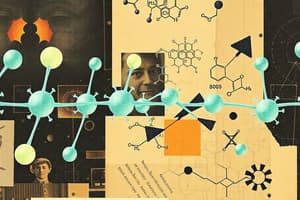Podcast
Questions and Answers
What does the kinetic molecular model primarily describe in relation to solids and liquids?
What does the kinetic molecular model primarily describe in relation to solids and liquids?
- The properties of gases under high pressure
- The behavior of particles in terms of energy and movement (correct)
- The fixed positions of particles in solids only
- The random motion of particles in a vacuum
Which type of intermolecular force is generally the weakest among the options provided?
Which type of intermolecular force is generally the weakest among the options provided?
- Dipole-dipole forces
- Ion-dipole forces
- Dispersion forces (correct)
- Hydrogen bonds
What property of liquids is primarily affected by intermolecular forces?
What property of liquids is primarily affected by intermolecular forces?
- Density
- Color
- Viscosity (correct)
- Conductivity
Which of the following is a characteristic of solids compared to liquids?
Which of the following is a characteristic of solids compared to liquids?
What role do hydrogen bonds play in the properties of water?
What role do hydrogen bonds play in the properties of water?
What is the primary requirement for hydrogen bonding to occur?
What is the primary requirement for hydrogen bonding to occur?
Which of the following atoms has the strongest ability to form hydrogen bonds?
Which of the following atoms has the strongest ability to form hydrogen bonds?
What is the relationship between intermolecular forces and the kinetic energy of molecules in solids?
What is the relationship between intermolecular forces and the kinetic energy of molecules in solids?
How does the electronegativity of oxygen affect a water molecule?
How does the electronegativity of oxygen affect a water molecule?
What phenomenon allows nonpolar particles to form dispersion forces temporarily?
What phenomenon allows nonpolar particles to form dispersion forces temporarily?
Which of the following properties is typically observed in solids but not in liquids?
Which of the following properties is typically observed in solids but not in liquids?
Which type of intermolecular force is strongest among the following?
Which type of intermolecular force is strongest among the following?
Which factors affect the amount of dispersion force in a molecule?
Which factors affect the amount of dispersion force in a molecule?
What effect does increasing polarity have on the boiling point of molecules of similar mass?
What effect does increasing polarity have on the boiling point of molecules of similar mass?
What is the effect of polarizability on boiling point?
What is the effect of polarizability on boiling point?
Which of the following molecules is least likely to engage in hydrogen bonding?
Which of the following molecules is least likely to engage in hydrogen bonding?
Which type of interaction is primarily responsible for the dissolving of ionic substances in polar solvents?
Which type of interaction is primarily responsible for the dissolving of ionic substances in polar solvents?
What property do liquids possess that differentiates them from solids?
What property do liquids possess that differentiates them from solids?
What type of intermolecular force is demonstrated when a helium atom is temporarily polarized?
What type of intermolecular force is demonstrated when a helium atom is temporarily polarized?
Which forces are collectively referred to as van der Waals forces?
Which forces are collectively referred to as van der Waals forces?
What occurs to the vibration of particles in a solid when heated?
What occurs to the vibration of particles in a solid when heated?
Study Notes
Hydrogen Bonds
- Hydrogen bonds develop from the attraction between a hydrogen atom and a highly electronegative atom (like nitrogen, oxygen, or fluorine) from another molecule.
- Electronegative atoms create hydrogen bonds due to their ability to interact with the nearly bare proton in hydrogen.
- Ammonia showcases hydrogen bonding with nitrogen, a highly electronegative atom, forming bonds with hydrogen atoms.
- Fluorine, being the most electronegative, results in the strongest hydrogen bonds.
- Water molecules have hydrogen bonds formed by oxygen, which attracts the shared electrons, creating a polar molecule (negative end near oxygen, positive ends near hydrogen).
Ion-Dipole Interactions
- Ion-dipole interactions occur in solutions where ions are present, enabling ionic substances to dissolve in polar solvents (e.g., Mg⁺, K⁺).
Dispersion Forces
- Dispersion forces can occur when nonpolar particles, like helium atoms, become temporarily polarized.
- The polarizability of an electron cloud contributes to the strength of dispersion forces.
Factors Affecting Dispersion Forces
- Increased number of electrons enhances dispersion force strength.
- Larger atomic or molecular size results in greater dispersion forces.
- The shape of molecules impacts dispersion forces; compact shapes tend to exhibit lower dispersion forces.
Polarizability & Boiling Point
- Easier polarizability correlates with lower boiling points, indicating weaker intermolecular forces.
- Smaller, lighter molecules with fewer electrons exhibit lower boiling points due to less intermolecular force.
Intermolecular Forces Summary
- Properties of solids: definite shape, incompressible, do not flow, expand minimally when heated.
- Properties of liquids: no definite shape, flow and take container's shape, can slightly expand when heated, more compressible than solids.
Intermolecular Forces of Attraction
- Intramolecular forces, like covalent bonds, are strong and hold compounds together, while intermolecular forces are weak and affect physical properties like boiling and melting points.
- Types of intermolecular forces, from weakest to strongest:
- Dispersion forces
- Dipole-dipole forces
- Hydrogen bonding
- Ion-dipole forces
- Dispersion and dipole-dipole forces are collectively referred to as van der Waals forces.
Dipole-Dipole Interactions
- Polar molecules exhibit dipoles (positive and negative ends) that attract oppositely charged ends, enhancing intermolecular attraction.
Trends in Physical Properties
- For molecules of similar mass, increased polarity raises boiling points noticeably.
- Hydrogen bonding results from particularly strong dipole-dipole interactions when hydrogen is bonded with N, O, or F.
Intermolecular Forces in Liquids and Solids
- Topics covered include the kinetic molecular model, types of intermolecular forces, and properties of liquids influenced by these forces (e.g., surface tension, viscosity, vapor pressure).
- Analysis of intermolecular forces helps in appreciating the chemical behavior of substances in everyday life.
Studying That Suits You
Use AI to generate personalized quizzes and flashcards to suit your learning preferences.
Description
This quiz explores the concept of hydrogen bonds, focusing on their formation and strength. It explains the role of highly electronegative atoms like nitrogen, oxygen, and fluorine in creating these interactions. Test your understanding of this fundamental concept in chemistry!




